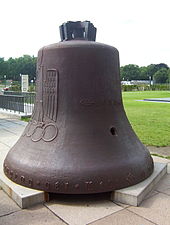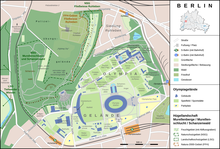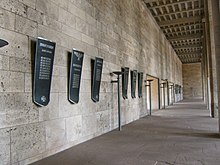Berlin bell tower

The bell tower on the Maifeld is a 77.17 meter high observation tower on the Berlin Olympic site in the Westend district . It was built in 1934–1936 according to plans by Werner March . The steel frame construction was clad with limestone slabs.
history

The bell tower was built for the 1936 Summer Olympics . For the Olympic Games in Berlin, observation stands for the festival management, the police, the medical service as well as radio and film reporting were housed in the numerous floors of the tower. The Langemarck Hall below celebrates the " Myth of Langemarck " with honors and sacrificial deaths. Tower and Langemarckhalle form as a West Wall designated hill Western limiting the Maifeld . It was created before the fortification of the same name was devised. During the construction phase, the bell tower was also called the "Führer Tower". Below the bell tower, in the grandstands facing the Maifeld, was the so-called “driver's cab”, under which large crowds of people could leave the “ Führer ” Adolf Hitler and greet the “ Führer ” Adolf Hitler through an eight meter wide gate .
The 4.28 meter high Olympic bell of the original tower - with a diameter of around 2.8 meters - was cast on August 14, 1935 by the Bochum Association for Cast Steel Manufacture and, after its ceremonial transfer, was lifted into the bell tower on May 11, 1936. The bell was transferred from Bochum to Berlin on a low-loader ( Culemeyer R 40 ) in January 1936 . The trip (“triumphal procession”) through various German cities was used extensively for propaganda for the Olympic Games in 1936 and “a re-strengthened empire ” and was also broadcast on the radio.
The Olympic bell was the logo of the 1936 Olympic Games. With the Olympic rings , the imperial eagle and the Brandenburg Gate on it and in connection with the Olympic torch relay , the Olympic flame in the stadium and the Olympic oath , the bell became a symbol of the Olympic Games in Berlin. At the bottom it was labeled: "Olympic Games 1936", swastikas and "I call the youth of the world". With the Olympic bell, following religious and Roman-ancient traditions, the Nazi regime claimed such for itself. In modern times, the secular use of bells spread across Europe. They were placed on war memorials to commemorate dead soldiers or between 1934 and 1936 were placed on the bell towers of the three NS-Ordensburgen - training centers for future leadership personnel ( cadres ) of the NSDAP . In the year of the Olympic Games in Berlin, Hans von Tschammer und Osten , since 1933 Reich Sports Leader and Commissioner and Chairman of the German Reich Association for Physical Exercise (DRL) and the National Socialist Reich Association for Physical Exercise (NSRL), declared the Olympic bell to be an "eternal reminder of our sacrificial death Heroes ”and an“ obligation ”for the living.

The 75-meter-long middle section of the Maifeldtribunes in front of the tower was not built as a wall, but rather as a three-storey building. The Reichsfilmarchiv was also housed in it during the Second World War . After the invasion of the Red Army , presumably due to the negligence of the military, this archive caught fire and the great heat was dissipated through the tower as if by a chimney. As a result, load-bearing parts of the steel skeleton were deformed. After this fire at the end of World War II, the tower was no longer stable and was blown up by British pioneers on February 15, 1947 .
The original 9.6 ton Olympic bell, which had not been removed before the explosion in 1947, fell into the depths during the action and was so badly damaged by a vertical crack that it could not be used for the reconstruction. To prevent metal theft , it was buried, rediscovered using metal detectors in 1956 and excavated on December 16 of the same year. In the meantime, the bell was also in front of a building at the Hanns-Braun-Stadion on the Olympic site . Today it is a memorial and meeting point on the south side of the Olympic Stadium .
location
From the Pichelsberg S-Bahn station ( S-Bahn lines S3 and S9) the route leads over Schirwindter Allee and Passenheimer Straße to the bell tower.
reconstruction
Between 1960 and 1962 the tower by Werner March under the old plans was rebuilt . In it hangs a new steel Olympic bell - weighing only 4 1 ⁄ 2 tons . Like the original bell, it was cast by the Bochum Association for Cast Steel Manufacture . It is decorated with representations of the federal eagle and the Brandenburg Gate and bears the text "Olympic Games 1936" and "I call the youth of the world" in connection with the Olympic rings on the lower edge . The bell produces the strike note f sharp o .
Langemarckhalle
The Langemarckhalle is located on the first floor at the foot of the tower . Other rooms on the floor and on the ground floor were used from 2006 to 2019 for the permanent multimedia exhibition “Olympia Site 1909 - 1936 - 2006” of the German Historical Museum . Renovation work began in 2019, and in the long term the Sports Museum Berlin is to move into the bell tower.
Panoramic view
The bell tower is open every day from April 1st to November 1st. An express elevator transports visitors to the viewing platforms, which offer a panoramic view of the nearby Olympic Park , the Olympic Stadium, the Waldbühne , the neighboring nature reserve Murellenberge, Murellenschlucht and Schanzenwald as well as in the distance over Berlin from Spandau to Alexanderplatz and with good visibility enable the Brandenburg area.
literature
- Manfred Uhlitz: The bell tower at the Olympic Stadium in Berlin. In: Communications from the Association for the History of Berlin. 76, 1989, ZDB -ID 3615-8 , pp. 173-177.
- Martin Kaule: Olympiastadion Berlin and Olympic Village Elstal. Ch. Links Verlag, Berlin 2014, ISBN 978-3-86153-766-3 .
- Stephan Brandt: From the Grunewald racecourse to the Olympic Stadium. Sutton Verlag, Erfurt 2015, ISBN 978-3954004942 .
Web links
Remarks
- ↑ In the book the weight of the bell is given as 16 tons instead of 9.6 tons. The higher figure could come from the fact that 16 tons of steel were used to cast the bell, but risers, filling cones etc. were of course removed.
- ↑ The weight of the bell in this source is 13 tons.
Individual evidence
- ↑ Exhibition and visitor center at the bell tower of the Olympic Park in Berlin: New and old tower
- ↑ a b Stephan Brandt: From the Grunewald Racecourse to the Olympic Stadium. Sutton Verlag, Erfurt 2015, ISBN 978-3954004942 , p. 71.
- ^ Werner March: Reichssportfeld building. Deutscher Kunstverlag, 1936, p. 28. Online at digilib.tu-graz.at .
- ↑ Karin Stöckel: Berlin in the Olympic frenzy. The organization of the Olympic Games in 1936. Diplomica Verlag , August 2009, ISBN 3-8366-6938-2 , p. 41 f.
- ^ Christian Bellinger: Functions and methods of the propagandistic staging of the Olympic Games of 1936. GRIN Verlag 2007, ISBN 3-638-77442-2 , p. 31.
- ^ Suetonius : Divus Augustus 91.2
- ↑ Information board on the Olympic site: The Olympic bell
- ↑ Exhibition and visitor center at the bell tower of the Olympic Park in Berlin: New and old tower
- ↑ Exhibition and Visitor Center Olympia Bell Tower (Ed.): Olympia 1936. Leaflet, approx. 2019.
- ↑ Berlin Olympic Bell. At: berlinstadtservice.de
- ↑ Exhibition and Visitor Center Olympia Bell Tower (Ed.): Olympia 1936. Leaflet, approx. 2019.
- ↑ Exhibition and Visitor Center Olympia Bell Tower (Ed.): Olympia 1936. Leaflet, approx. 2019.
Coordinates: 52 ° 30 ′ 50 ″ N , 13 ° 13 ′ 54 ″ E






